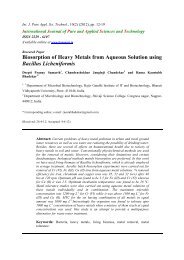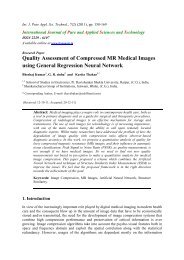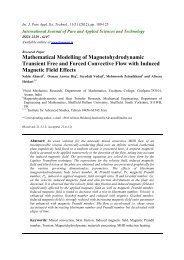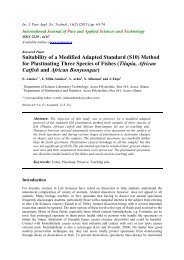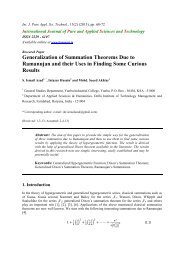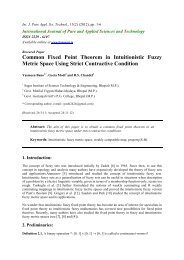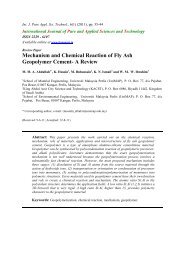Tanzania Sisal Industry: Auditing and Characterization of Sisal Post ...
Tanzania Sisal Industry: Auditing and Characterization of Sisal Post ...
Tanzania Sisal Industry: Auditing and Characterization of Sisal Post ...
- No tags were found...
You also want an ePaper? Increase the reach of your titles
YUMPU automatically turns print PDFs into web optimized ePapers that Google loves.
Int. J. Pure Appl. Sci. Technol., 14(2) (2013), pp. 84-94<br />
International Journal <strong>of</strong> Pure <strong>and</strong> Applied Sciences <strong>and</strong> Technology<br />
ISSN 2229 - 6107<br />
Available online at www.ijopaasat.in<br />
Research Paper<br />
<strong>Tanzania</strong> <strong>Sisal</strong> <strong>Industry</strong>: <strong>Auditing</strong> <strong>and</strong> <strong>Characterization</strong><br />
<strong>of</strong> <strong>Sisal</strong> <strong>Post</strong>-Harvest Wastes as a Bio-Resource for Bio-<br />
Refining<br />
Anthony Manoni Msh<strong>and</strong>ete 1, *, Oscar Kibazohi 2 <strong>and</strong> Amelia Kajumulo Kivaisi 1<br />
1 Department <strong>of</strong> Molecular Biology <strong>and</strong> Biotechnology, College <strong>of</strong> Natural <strong>and</strong> Applied Sciences,<br />
Uvumbuzi Road, Mwl. J.K. Nyerere Mlimani Campus, University <strong>of</strong> Dar es Salaam, P.O. Box 35179,<br />
Dar es Salaam, <strong>Tanzania</strong><br />
2 Department <strong>of</strong> Chemical <strong>and</strong> Mining Engineering, College <strong>of</strong> Engineering <strong>and</strong> Technology,<br />
University <strong>of</strong> Dar es Salaam, P.O. Box 35131, Dar es Salaam, <strong>Tanzania</strong><br />
* Corresponding author, e-mail: (Anthony.msh<strong>and</strong>ete@yahoo.com; msh<strong>and</strong>ete@amu.udsm.ac.tz)<br />
(Received: 11-12-12; Accepted: 5-2-13)<br />
Abstract: A waste audit case study was conducted for sisal post-harvest waste<br />
(SPHW) generated at Fatemi sisal estates in <strong>Tanzania</strong> to evaluate its potential for<br />
use as substrate for mushroom cultivation <strong>and</strong> biogas production by integrating<br />
quantitative with qualitative methods <strong>and</strong> laboratory analysis. Annual generation<br />
<strong>of</strong> fresh sisal boles waste (SBW) <strong>and</strong> remnant leaf stubs (RLS) per hectare was<br />
estimated at 22 <strong>and</strong> 44.5 tons, respectively. The chemical compositions <strong>of</strong> SBW<br />
<strong>and</strong> RLS as well as the leachate extracted from the fractions were established.<br />
Regardless <strong>of</strong> the fraction analyzed, contents <strong>of</strong> volatile solids, total carbon, total<br />
organic matter were in the ranges <strong>of</strong> 93-98%, 49-55% <strong>and</strong> 91-98% on dry weight<br />
basis, respectively. Total sugar contents <strong>of</strong> the solid <strong>and</strong> liquid fractions ranged<br />
between 8-27% <strong>and</strong> 30-35 mg/l, respectively. The chemical oxygen dem<strong>and</strong><br />
(COD) content <strong>of</strong> the SBW <strong>and</strong> RLS fractions were between 20 <strong>and</strong> 26 gO 2 /l,<br />
respectively. The high values <strong>of</strong> organics contained in the SPHW fractions is<br />
indicative <strong>of</strong> its potential as feedstock for a biorefinery that produces food<br />
(mushroom), feed, bi<strong>of</strong>uels (biogas, bioethanol), biochemicals <strong>and</strong> other<br />
bioproducts. On the basis <strong>of</strong> the established characteristics, an innovative<br />
approach for the utilization <strong>of</strong> the waste is proposed.<br />
Keywords: <strong>Sisal</strong> waste, biorefinery, utilization, management.
Int. J. Pure Appl. Sci. Technol., 14(2) (2013), 84-94 85<br />
1. Introduction<br />
<strong>Sisal</strong> is a semiarid <strong>and</strong> marginal l<strong>and</strong> crop <strong>of</strong> the tropics whose leaves are used for extraction into<br />
natural hard fibers by either wet or dry decortications (Kimaro et al., 1994). <strong>Tanzania</strong> is the forth<br />
world's largest sisal producer currently at 24,600 tons <strong>of</strong> sisal products per annum earning the country<br />
foreign exchange through exports. However, sisal fibre production is a high waste process currently<br />
using only 2% <strong>of</strong> the plant <strong>and</strong> the remaining 98% biomass being various fractions <strong>of</strong> wastes. <strong>Sisal</strong><br />
processing wastes include; sisal leaf decortications wastes (SLDW), short fibres (flume tow),<br />
wastewater <strong>and</strong> sisal dust. The industry also produces post harvest waste (SPHW) that comprises <strong>of</strong><br />
sisal stems (comprising <strong>of</strong> boles <strong>and</strong> leaf remnant stubs) <strong>and</strong> poles (Muthangya et al., 2009). SLDW<br />
is commonly disposed <strong>of</strong>f raw into the environment <strong>and</strong> SPHW is disposed <strong>of</strong>f before replanting <strong>and</strong><br />
mostly by burning.<br />
Although currently a menace to the environment, the 98% could be regarded as a bioresource not a<br />
waste (TSA, 1995;Bis<strong>and</strong>a <strong>and</strong> Enock, 2003). <strong>Sisal</strong> waste is now known to be more valuable than the<br />
2% <strong>of</strong> fibre if fully exploited to produce high value commodities such as edible mushrooms, bi<strong>of</strong>uels,<br />
bi<strong>of</strong>ertilizer, foam liquid (cement foaming substance which enlarge s<strong>and</strong> <strong>and</strong> cement mixture),<br />
organic acids (lactic acid, citric acid, acetone, butanol), composite, low calorie dietary fibers,<br />
functional foods, sweeteners, thickeners in ice creams, s<strong>and</strong>wich spreads, chocolate products, breads<br />
<strong>and</strong> pastries etc, fine <strong>and</strong> green chemicals (Kimaro et al., 1994; TSA, 1995;Bis<strong>and</strong>a <strong>and</strong> Enock,<br />
2003; Muruke et al., 2006; Msh<strong>and</strong>ete <strong>and</strong> Cuff, 2008; Elisante <strong>and</strong> Msemwa, 2010;Msh<strong>and</strong>ete,<br />
2011). Adding value to waste will make the industry more competitive through diversification <strong>of</strong> its<br />
markets. Despite this big potential, it is only one factory in <strong>Tanzania</strong> that is utilizing SLDW at<br />
industrial scale for biogas to electricity generation <strong>of</strong> 150-300 KWh/day from a 1700 m 3 biogas plant<br />
since 2007. As for the rest, sisal waste remains grossly underutilized.<br />
In order to be able to utilize sisal waste for commercial production, information on their availability,<br />
quantity <strong>and</strong> composition is crucial. Whereas elaborate information on generation rates <strong>and</strong><br />
characteristics <strong>of</strong> sisal wastewater <strong>and</strong> decortications waste is provided in the literature (Msh<strong>and</strong>ete et<br />
al., 2004; Msh<strong>and</strong>ete et al., 2006; Muthangya et al., 2009) while that on SPHW is scanty (Msh<strong>and</strong>ete,<br />
2011). The aim <strong>of</strong> this study was to establish the quantity <strong>and</strong> quality <strong>of</strong> SPHW available for<br />
cultivation <strong>of</strong> oyster mushrooms <strong>and</strong> using the spent SPHW for biogas production.<br />
2. Materials <strong>and</strong> Methods<br />
2.1 Waste Quantification<br />
Quantification <strong>of</strong> SPHW involved a field survey to Fatemi sisal estate, which is owned by<br />
Mohammed Enterprises <strong>Tanzania</strong> Ltd (MeTL) <strong>and</strong> is located in Morogoro, <strong>Tanzania</strong> for site<br />
reconnaissance. Information was gathered on acreage <strong>of</strong> the estate, sisal density <strong>of</strong> sisal plants per<br />
hectare, rates <strong>of</strong> generation <strong>of</strong> the waste <strong>and</strong> its current management methods through guided<br />
interviews <strong>of</strong> the estate management staff.<br />
Twelve samples <strong>of</strong> sisal boles with the attached leaf stubs were collected r<strong>and</strong>omly from one-hectare<br />
farm area <strong>and</strong> transported to the laboratory. They were each weighed before the leaf stubs were<br />
removed from the core-sisal boles by using a machete <strong>and</strong> categorized by weight to small, medium,<br />
large <strong>and</strong> extra-large. The fresh weights <strong>of</strong> the core-boles <strong>and</strong> leaf stubs fractions were recorded. Both<br />
fractions were then chopped into 3-5 cm pieces <strong>and</strong> dried in the sun <strong>and</strong> their weights recorded once<br />
more. Fresh <strong>and</strong> dry samples <strong>of</strong> the two fractions were taken for physico-chemical analysis according<br />
to Gumisiriza et al. (2009).
Int. J. Pure Appl. Sci. Technol., 14(2) (2013), 84-94 86<br />
2.2 SPHW Leachate (juice) Extraction<br />
The chopped pieces <strong>of</strong> the core-bole <strong>and</strong> leaf stubs were crushed <strong>and</strong> minced using a laboratory<br />
mincer. One hundred grams <strong>of</strong> the processed core-bole <strong>and</strong> leaf stubs were weighed using an<br />
Adventurer TM balance (Ohaus Corp, Pine Brook, NJ, USA) each separately into 1000 ml <strong>of</strong> tap<br />
water. Extraction <strong>of</strong> leachate (juice) from core-bole <strong>and</strong> leaf stubs was done by hot water extraction<br />
method according to Gaafar et al. (2010). The mixtures <strong>of</strong> core-bole <strong>and</strong> leaf stubs <strong>and</strong> tap water were<br />
brought to a boil at 100°C in two separate pans using a laboratory table hot plate (E.G.O. (Elektro-<br />
Gerätebau GmbH), Germany) <strong>and</strong> boiling was continued for 20 minutes. The boiled slurry was left to<br />
cool to room temperature. To extract the leachate (juice) the slurry was squeezed manually through<br />
two layers <strong>of</strong> cheesecloth. The filtrate obtained was subsequently filtered manually by squeezing<br />
through a 2 mm mesh size plastic sieve. The extracted liquid was referred to as leachate (juice). The<br />
solid left after leachate (juice) extraction was sun dried for five days <strong>and</strong> was referred to as biomass<br />
residue after leachate (juice) extraction.<br />
2.2 Analytical Methods<br />
Determination <strong>of</strong> total solids (TS), volatile solids (VS), total nitrogen (TN), ash content, chemical<br />
oxygen dem<strong>and</strong> (COD), biological oxygen dem<strong>and</strong> (BOD 5 ) was done according to st<strong>and</strong>ard methods<br />
(APHA, 1995). On the other h<strong>and</strong>, total carbon was estimated according to Allen (1989) <strong>and</strong> Nelson<br />
<strong>and</strong> Sommer (1996). The organic matter content was determined by the dry combustion method<br />
described by Jiménez <strong>and</strong> García (1992) <strong>and</strong> Lyimo et al. (2002). Total fibers were determined by the<br />
permanganate method as Neutral detergent fiber (NDF) <strong>and</strong> Acid detergent fiber (ADF) according to<br />
Goering <strong>and</strong> Van Soest (1970). Total sugars <strong>of</strong> SPHW fractions were determined by phenol-sulphuric<br />
acid method according to Dubois et al. (1956). Total dissolved solids (TDS), conductivity <strong>and</strong> pH<br />
were measured using a portable pH microprocessor probe <strong>and</strong> meter (HANNA-Italy). Minerals<br />
content were determined as described by AOAC (1984) <strong>and</strong> Allen (1989). Crude fiber was<br />
determined using Near Infrared Spectrophotometer (NIRSystems, Inc, USA). Volatile fatty acids <strong>and</strong><br />
alkalinity were determined by titration method described by Buchauer (1998) <strong>and</strong> Lahav <strong>and</strong> Morgan<br />
(2004).<br />
3. Results<br />
3.1 SPHW Production <strong>and</strong> Disposal at Fatemi <strong>Sisal</strong> Estate<br />
The sisal plant currently grown at Fatemi sisal estate is Agave hybrid 11648. The estate’s area under<br />
cultivation is 2,000 hectares each with a population <strong>of</strong> 5,000 plants grown in double rows. The sisal<br />
post harvest wastes comprises <strong>of</strong> sisal poles, core-sisal boles <strong>and</strong> stubs <strong>of</strong> leaves that remain on the<br />
boles after every cutting. The sisal bole is the intermediate part between roots <strong>and</strong> stem covered with<br />
a hard lignified cortical layer or bark <strong>of</strong> 2-3 mm thick, onto which leaves are attached. SPHW<br />
fractions account for 50% <strong>of</strong> the sisal plant <strong>and</strong> are produced at the end <strong>of</strong> the plants’ productive life<br />
(6-12 years). The average weights <strong>of</strong> the various sizes <strong>of</strong> sisal boles with the attached leaf stubs are<br />
shown in Table 1. The weights <strong>of</strong> the core-boles <strong>and</strong> leaf stubs ranged between 19 <strong>and</strong> 129 kg. The<br />
largest <strong>and</strong> smallest core-sisal boles without leaf stubs weighed between 44 <strong>and</strong> 4 kg <strong>and</strong> their sisal<br />
leaf stubs weighed between 85 <strong>and</strong> 15 kg, respectively. Generally, the weight <strong>of</strong> the leaf stubs<br />
contributed much more to the total weight <strong>of</strong> the waste than the core-boles (Figure 1).<br />
Poling <strong>of</strong> sisal plants is not uniform <strong>and</strong> differs even on the same plot due to many factors including<br />
type <strong>of</strong> soil <strong>and</strong> available soil nutrients, dry <strong>and</strong> rainy season, temperature, humidity <strong>and</strong> other microclimate<br />
factors. Experience revealed that after 3-4 years <strong>of</strong> economic life, about 40-50% <strong>of</strong> the plants<br />
are uprooted <strong>and</strong> 80-90 % are uprooted within 5-12 years in order to replant the farm. Therefore it is<br />
assumed that each year 10 % <strong>of</strong> sisal plants are uprooted before replanting new ones. Based on X-
Int. J. Pure Appl. Sci. Technol., 14(2) (2013), 84-94 87<br />
large category (44 kg sisal bole <strong>and</strong> 85 kg sisal leaves remains), about 22 tons <strong>and</strong> 42.5 tons <strong>of</strong> sisal<br />
boles <strong>and</strong> leaf stubs, respectively can be projected per hectare annually from Fatemi sisal estate.<br />
When sisal boles <strong>and</strong> sisal leaves remains were chopped <strong>and</strong> sun dried for seven days, they became<br />
35% <strong>and</strong> 38%, respectively <strong>of</strong> their original fresh biomass. These translate into an annual production<br />
<strong>of</strong> about 15,000 tons <strong>of</strong> dry sisal boles <strong>and</strong> 32,000 tons <strong>of</strong> sisal leaf stubs. Currently, the boles are<br />
crushed <strong>and</strong> left to rot on the farm <strong>and</strong> the poles are sold/<strong>and</strong> or given for free to be used by the local<br />
community around the factory.<br />
3.2 <strong>Characterization</strong> <strong>of</strong> SPHW<br />
The chemical compositions <strong>of</strong> the various fractions <strong>of</strong> the core-sisal boles <strong>and</strong> the leaf stubs are<br />
shown in (Tables 2 <strong>and</strong> 3). Generally, the solid fractions were rich in biodegradable substances in<br />
terms <strong>of</strong> volatile solids (VS) in the range <strong>of</strong> 93-98% <strong>and</strong> total sugars ranging between 8 <strong>and</strong> 27 mg/l.<br />
The fresh SBW fraction had the highest VS content <strong>and</strong> its dried fraction had the least. On the part <strong>of</strong><br />
total sugar content, the fresh RLS fraction had the highest content whereas the biomass residue after<br />
leachate extraction from the same had the least content. Furthermore, the solid fractions were<br />
characterized by high crude fiber content in the range <strong>of</strong> 25-81% <strong>and</strong> high C:N ratios ranging between<br />
24 <strong>and</strong> 285. The biomass residue after leachate extraction from SBW fraction had the highest crude<br />
fiber <strong>and</strong> C:N ratio values. Similar to the solid fractions, the leachate extracts were found to be rich in<br />
biodegradable substances in terms <strong>of</strong> VS at about 93 <strong>and</strong> 97% <strong>and</strong> in total sugars at about 30 <strong>and</strong> 35<br />
mg/l whereby the leachate from the RLS fraction had the highest content <strong>of</strong> VS <strong>and</strong> total sugars.<br />
4. Discussion<br />
4.1 Quantification <strong>of</strong> <strong>Sisal</strong> <strong>Post</strong>-Harvest Waste<br />
Availability <strong>of</strong> a substrate in abundance <strong>and</strong> at low or not cost is the basis for choosing to utilize it for<br />
industrial production <strong>and</strong> in this context SPHW qualifies. In this case study, the annual generation <strong>of</strong><br />
SBW <strong>and</strong> RLS fractions was estimated at 15,000 <strong>and</strong> 32,000 tons <strong>of</strong> dry weight, respectively for the<br />
2000 ha Fatemi sisal estate (Table 1 <strong>and</strong> Figure 1). Applying this generation estimation rate to a total<br />
<strong>of</strong> 52,000 hectares under cultivation in <strong>Tanzania</strong> (Semotony, 2012), total SPHW generation by the<br />
sisal industry amounts to 1,222,000 tons annually. To our knowledge, this study is for the first time<br />
reporting elaborate information on generation <strong>of</strong> SPHW in <strong>Tanzania</strong>, <strong>and</strong> the region. Brief<br />
information on relative weights <strong>of</strong> sisal boles, which tallies with the findings <strong>of</strong> this study was<br />
reported by Kimaro et al. (1994).<br />
4.2 Composition <strong>of</strong> <strong>Sisal</strong> <strong>Post</strong>-Harvest Waste Fractions<br />
Suitability <strong>of</strong> any biomass as feedstock for processing to bioproducts very much depends on its<br />
chemical characteristics (Table 2 <strong>and</strong> 3). The various solid fractions <strong>of</strong> SBW <strong>and</strong> RLS were<br />
characterized by high organic matter contents <strong>of</strong> up to 97% in terms <strong>of</strong> VS <strong>and</strong> about 55% in terms <strong>of</strong><br />
total organic carbon. These values are similar to those obtained previously for sisal leaf<br />
decortications pulp by Msh<strong>and</strong>ete et al. (2004) <strong>and</strong> Muthangya et al. (2009). Apart from high organic<br />
carbon content, the fractions had high total sugar contents in the range <strong>of</strong> 8-27%. These results are in<br />
agreement with the high (16.3%) inulin sugar content reported by Elisante <strong>and</strong> Msemwa (2010) for<br />
sisal boles. Furthermore, all the fractions showed low hence safe levels <strong>of</strong> light metals including Na,<br />
Mg <strong>and</strong> Ca, which are required for microbial growth but cause inhibitory effects when found in high<br />
proportions as previously documented (Chen et al., 2008). Judging from their solid <strong>and</strong> organic<br />
matter content, the total sugars in particular, the waste fractions generally contain easily<br />
biodegradable substances hence potential feedstocks for bioconversion to a wide range <strong>of</strong> value<br />
added products such as organic acids, alcohols, pharmaceutical chemicals <strong>and</strong> biogas through<br />
applying a biorefinery approach (Francesco, 2010).
Int. J. Pure Appl. Sci. Technol., 14(2) (2013), 84-94 88<br />
Despite the high organic matter pr<strong>of</strong>ile, the fractions had high crude fiber content ranging between 25<br />
<strong>and</strong> 81%. This characteristic makes the fractions to be categorized as heavily biodegradable<br />
(hydrolysable) materials requiring pre-treatment for subsequent bioprocessing including when<br />
anaerobic digestion is an option. Besides, their high C:N ratio in the range <strong>of</strong> 24-201 necessitates codigestion<br />
with nitrogen rich materials for an improved anaerobic digestion process (Mata-Alvarez et<br />
al., 2012). This effect was previously demonstrated by Msh<strong>and</strong>ete et al. (2004) by co-digesting sisal<br />
decortications pulp with fish processing waste.<br />
This study further characterized the extracts (leachates) <strong>of</strong> the waste fractions to explore the<br />
possibility <strong>of</strong> utilizing them instead <strong>of</strong> the solid materials. The chemical pr<strong>of</strong>iles <strong>of</strong> the leachates from<br />
the fresh SBW <strong>and</strong> RLS were to a greater extent found to be similar to those <strong>of</strong> their original fractions<br />
(Tables 2 <strong>and</strong> 3). Use <strong>of</strong> the leachate instead <strong>of</strong> the solid fractions may be an innovative approach for<br />
easy h<strong>and</strong>ling <strong>and</strong> pumping in bioreactor systems. The leachate extraction cost may be <strong>of</strong>f-set by the<br />
benefits considering the sample percolation methods available (Gaafar et al., 2010). If the option is<br />
anaerobic digestion for biogas production, biomass percolation has been shown to increase methane<br />
production <strong>and</strong> ensure waste stabilization (Busch et al., 2009). The biomass residues after leachate<br />
extraction was characterized by very high crude fiber values in the range <strong>of</strong> 63-81% <strong>and</strong> their total<br />
sugar content was about 50% <strong>of</strong> that obtained for the original fractions <strong>and</strong> the leachates.<br />
Nevertheless, the rest <strong>of</strong> the parameters were similar to the rest <strong>of</strong> the fractions, which still makes<br />
them potentially suitable substrates for bioconversion to a number <strong>of</strong> products including mushrooms<br />
4.3 Proposed Integrated Utilization <strong>of</strong> <strong>Sisal</strong> <strong>Post</strong>-Harvest Waste<br />
As mentioned previously, sisal fiber production is conventionally a high waste industry with low<br />
pr<strong>of</strong>itability at high capitalization hence unable to be sustainable <strong>and</strong> compete in the global market<br />
(UNIDO, 2002). In order to ensure ecologically sustainable industrial development, reversal <strong>of</strong> the<br />
current situation from utilizing only 2% <strong>of</strong> the sisal plant to 98% was proposed under the Cleaner<br />
Production Programme (UNIDO, 2005). This would be achieved through diversifying processing <strong>and</strong><br />
products. From the sisal leaf decortications waste, production <strong>of</strong> wax, alcohols <strong>and</strong> other chemicals or<br />
biogas <strong>and</strong> bi<strong>of</strong>ertilizer was proposed. For the post-harvest waste (boles <strong>and</strong> roots), they proposed<br />
production <strong>of</strong> alcohol, inulin <strong>and</strong> pharmaceutical chemicals. On the basis <strong>of</strong> the results <strong>of</strong> this study,<br />
we propose an innovative two-in-one approach within the UNIDO framework (Figure 2). In the first<br />
option, the entire sisal bole is used for cultivation <strong>of</strong> mushrooms <strong>and</strong> the mushroom spent substrate is<br />
co-digested with cow-dung manure anaerobically for biogas production. The effluent <strong>of</strong> the process<br />
known as biogas manure is valuable bi<strong>of</strong>ertilizer. In the second option, the two fractions may be<br />
utilized together or separately depending on the desired products. Here, the chopped <strong>and</strong> crushed<br />
fractions are used for leachate extraction <strong>and</strong> the leachate may be used in a biorefinery for production<br />
<strong>of</strong> a wide range <strong>of</strong> products such as inulin, organic acids, ethanol <strong>and</strong> biogas. The biomass residue<br />
after leachate extraction may be utilized for mushroom cultivation as well as for animal feed<br />
production using white rot fungi. Again the mushroom spent substrate may be a feedstock for<br />
anaerobic digestion process. Unlike the UNIDO proposal for the post-harvest waste, this approach<br />
has more options for more products giving the industry more flexibility in choices, which is an<br />
additional competitive advantage.<br />
5. Conclusions<br />
Although highly fibrous <strong>and</strong> poor in nitrogen, sisal post-harvest waste produced by cultivation <strong>of</strong><br />
Agave hybrid 11648 has high contents <strong>of</strong> organic matter <strong>and</strong> rich in total sugars. These characteristics<br />
make it potentially suitable for production <strong>of</strong> a wide range <strong>of</strong> high value commodities. The waste<br />
generated by Fatemi sisal estate is currently available for free <strong>and</strong> in abundance awaiting exploitation.
Int. J. Pure Appl. Sci. Technol., 14(2) (2013), 84-94 89<br />
Tables <strong>and</strong> Figures:<br />
Table1: Weights <strong>of</strong> different size categories <strong>of</strong> sisal boles <strong>and</strong> leaf stubs.<br />
Size<br />
Core-<strong>Sisal</strong> bole<br />
(kg)<br />
(Mean±SD, n=3)<br />
<strong>Sisal</strong> leaf<br />
stubs<br />
(kg)<br />
Small 4±2.0 15±2 19<br />
Medium 16±1.5 38±1 54<br />
Large 34 ±1.0 84±2 118<br />
X-Large 44 ±2.0 85±3 129<br />
Total weight<br />
(kg)<br />
Table 2: Chemical characteristics <strong>of</strong> SBW fractions (Mean±SD, n=3)<br />
Parameter Fresh Dry fraction Biomass residue after Leachate<br />
fraction<br />
leachate extraction<br />
Total solids (TS 30.91±0.95 80.88±7.18 36.05±0.75 9.72±0.01<br />
%)<br />
VS (% TS) 98.17±0.52 93.27±1.43 94.19±0.60 93.51±1.50<br />
Total carbon 54.4±0.55 52.69±0.16 54.81±0.32 54.24±0.27<br />
(%TS)<br />
Total Nitrogen 1.13±0.13 1.46±0.02 0.22±0.02 1.24±0.13<br />
(%TS)<br />
C:N ratio 48:1 36:1 285:1 44:1<br />
Total organic 97.99±1 94.83±0.28 98.66±0.58 97.63±0.49<br />
matter (%TS)<br />
Total sugars 15.32±3.91 13.27±0.91 8.45±0.50 30.24±2.26<br />
Crude fibers 51.43±1.06 40.35±1.06 81.17±2.34 1.1±0.13<br />
(%TS)<br />
NDF (%) ND 22.7±0.36 ND ND<br />
ADF (%) ND 20.18±0.07 ND ND<br />
Hemicellulose 20.14±1.89 10.14±0.89 8.14±0.22 6.41±0.26<br />
(%TS)<br />
Ash content 1.83±0.52 6.73±1.43 5.80±0.60 6.48±1.50<br />
(%TS)<br />
Calcium (%TS) 4.13±0.13 5.32±0.16 4.96±0.28 8.14±0.10<br />
Magnesium (%TS) 0.20±0.02 0.62±0.12 0.12±0.01 2.10±0.11<br />
Potassium (%TS) 1.18±0.09 1.34±0.23 0.79±0.31 1.24±0.16<br />
Phosphorus (%TS) 0.11±0.01 0.25±0.05 0.10±0.01 1.42±0.21<br />
Sulphate (%TS) 0.03±0.01 0.04±0.01 0.01±0.001 3.52±0.98<br />
pH ND ND ND 5.77±0.07<br />
Conductivity ND ND ND 3,970±2<br />
(µS/cm)<br />
TDS (ppm) ND ND ND 1,983±3<br />
COD (g/l) ND ND ND 20.07±0.13
Int. J. Pure Appl. Sci. Technol., 14(2) (2013), 84-94 90<br />
BOD 5 (g/l) ND ND ND 16±0.16<br />
VFA (mg/l) ND ND ND 2,862±6.8<br />
Alkalinity (mg/l) ND ND ND 121±1<br />
ND=Not Determined<br />
Table 3: Chemical characteristics <strong>of</strong> RLS fractions. (Mean±SD, n=3)<br />
Parameter Fresh Dried fraction Biomass residue after Leachate<br />
fraction<br />
leachate extraction<br />
Total solids 33.55±0.56 87.80±0.51 37.01±1.41 10.07±0.25<br />
(%fresh)<br />
Volatile 96.8±0.24 94.3±3.3 96.84±0.34 95.78±0.35<br />
solids(%TS)<br />
Total carbon 54.6±0.32 50.92±1.70 54.37±0.33 48.74±0.45<br />
(%TS)<br />
Total Nitrogen 1.62±0.11 2.16±0.01 0.27±0.04 2.14±0.76<br />
(%TS)<br />
C:N ration 34:1 24:1 201:1 23:1<br />
Total organic 98.32±0.58 91.66±3.06 97.87±0.21 87.53±1.10<br />
matter (%TS)<br />
Total sugars 27.41±2.28 26.20±1.28 14.27±4.16 35.24±2.50<br />
Crude fibers 56.91±2.71 72.16±2.78 63.25±1.26 1.26±0.66<br />
(%TS)<br />
NDF (%) ND 35.91±0.11 ND ND<br />
ADF (%) ND 32.76±0.29 ND ND<br />
Hemicellulose 31.19±1.12 12.16±1.50 11.26±1.24 11.26±1.24<br />
(%TS)<br />
Ash content 3.1±0.24 5.69±3.29 3.15±0.34 4.04±0.22<br />
(%TS)<br />
Calcium (%TS) 3.30±0.30 5.62±0.38 5.62±0.38 10.12±0.50<br />
Magnesium (%TS) 0.16±0.01 0.52±0.11 0.10±0.02 2.16±0.12<br />
Potassium (%TS) 3.60±0.53 5.26±1.53 0.55±0.04 1.37±0.31<br />
Phosphorus (%TS) 0.31±0.01 0.22±0.02 0.05±0.01 3.50±0.60<br />
Sulphate (%TS) 0.05±0.01 0.05±0.01 0.01±0.001 6.70±1.54<br />
pH ND ND ND 5.36±0.04<br />
Conductivity ND ND ND 2,785±5<br />
(µS/cm)<br />
TDS (ppm) ND ND ND 1,390±2<br />
COD (g/l) ND ND ND 26.24±0.21<br />
BOD 5 (g/l) ND ND ND 20.8±0.27<br />
VFA (mg/l) ND ND ND 140.85±3.7<br />
Alkalinity (mg/l) ND ND ND 102±1.5<br />
ND=Not Determined
Int. J. Pure Appl. Sci. Technol., 14(2) (2013), 84-94 91<br />
Figure 1: Contribution <strong>of</strong> Core-boles <strong>and</strong> leaf stubs to total bole weight
Int. J. Pure Appl. Sci. Technol., 14(2) (2013), 84-94 92<br />
Poles<br />
<strong>Sisal</strong> <strong>Post</strong>-harvest waste<br />
<strong>Sisal</strong> boles including leaf<br />
stubs<br />
Construction<br />
materials<br />
Chopping, crushing, leachate<br />
extraction<br />
Chopping, drying, grinding<br />
Biomass<br />
residue<br />
Leachate<br />
Mushroom cultivation<br />
Mushrooms: To<br />
markets<br />
Chemical/fermentation processing<br />
Spent mushroom substrate<br />
Inulin, organic acids,<br />
ethanol, biogas, etc.<br />
Co-digestion with animal<br />
manures for biogas<br />
Biogas<br />
Bi<strong>of</strong>ertilizer to sisal plantations<br />
Figure 2: Proposed integrated utilization <strong>of</strong> sisal post-harvest waste.
Int. J. Pure Appl. Sci. Technol., 14(2) (2013), 84-94 93<br />
Acknowledgements<br />
We wish to acknowledge the Swedish International Development Cooperation Agency (Sida) for the<br />
financial support. We thank the BIO-INNOVATE programme for including environmental<br />
biotechnology as one <strong>of</strong> the research themes in the programme. The participation <strong>of</strong> Fatemi <strong>Sisal</strong><br />
Estate Management under the leadership <strong>of</strong> Mohammed Enterprise <strong>Tanzania</strong> Limited (MeTL) is<br />
highly appreciated.<br />
References<br />
[1] S.E. Allen, Chemical Analysis <strong>of</strong> Ecological Material (2nd Ed.), Blackwell Scientific<br />
Publications, Oxford, U.K., 1989.<br />
[2] American Public Health Association, APHA, St<strong>and</strong>ard methods for Examination <strong>of</strong> Water<br />
<strong>and</strong> Wastewater (20 th Ed.), American Public Health Association, Washington, D.C., 1998.<br />
[3] Association <strong>of</strong> Official Analytical Chemists, AOAC, Official Methods <strong>of</strong> Analysis <strong>of</strong> the<br />
Association <strong>of</strong> Official Analytical Chemists (14 th Ed.), Arlington, Virginia, 1984.<br />
[4] K.A. Baucher, Comparison <strong>of</strong> two simple titration procedures to determine volatile fatty<br />
acids in influents to wastewater <strong>and</strong> sludge treatment processes, Water. SA., 24(1998), 49-56.<br />
[5] E.T.N. Bis<strong>and</strong>a <strong>and</strong> J. Enock, Review on sisal waste utilization: Challenges <strong>and</strong><br />
opportunities, Discov. Innovat., 18(2003), 17-27.<br />
[6] G. Busch, J.M. Großmann, M. Sieber <strong>and</strong> M. Burkhardt, A new <strong>and</strong> sound technology for<br />
biogas from solid waste <strong>and</strong> biomass, Water Air Soil Pollut: Focus, 9(2009), 89-97.<br />
[7] Y. Chen, J.J. Cheng <strong>and</strong> K.S. Creamer, Inhibition <strong>of</strong> anaerobic digestion process: A review,<br />
Bioresour. Technol., 99(2008), 4044-4064.<br />
[8] M.K.A. Dubois, J.K. Gilles, P.A. Hamilton <strong>and</strong> F.S. Rebers, Calorimetric method for<br />
determination <strong>of</strong> sugars <strong>and</strong> related substances, Anal. Chem., 28(1956), 350-356.<br />
[9] E. Elisante <strong>and</strong> V. Msemwa, Dry method for preparation <strong>of</strong> inulin biomass as a feedstock for<br />
ethanol fermentation, Afr. Crop Sci J., 18(2010), 215-222.<br />
[10] C. Francesco, The biorefinery concept: Using biomass instead <strong>of</strong> oil for producing energy<br />
<strong>and</strong> chemicals, Energ. Convers. Manage, 5(2010), 1412-1421.<br />
[11] A.M. Gaafar, F.M. Serag, E. El-Din, A. Boudy <strong>and</strong> H.H. El-Gazar, Extraction conditions <strong>of</strong><br />
inulin from Jerusalem Artichoke tubers <strong>and</strong> its effects on blood glucose <strong>and</strong> lipid pr<strong>of</strong>ile in<br />
diabetic rats, J. Am. Sci., 6(2010), 36-43.<br />
[12] H.K. Goering <strong>and</strong> P.J. van Soest, Forage fibre analysis (apparatus, reagents, procedures <strong>and</strong><br />
some applications), In Agricultural H<strong>and</strong>book, Agricultural Research Service, United States<br />
Department <strong>of</strong> Agriculture: Washington DC., 1970.<br />
[13] R. Gumisiriza, A.M. Msh<strong>and</strong>ete, M.S.T. Rubindamayugi, F. Kansiime <strong>and</strong> A.K. Kivaisi, Nile<br />
perch fish processing waste along Lake Victoria in East Africa: <strong>Auditing</strong> <strong>and</strong><br />
characterization, Afr. J. Environ. Sci. Technol., 3(2009), 013-020.<br />
[14] E.I. Jiménez <strong>and</strong> V.P. García, Relationships between organic carbon <strong>and</strong> total organic matter<br />
in municipal solid wastes <strong>and</strong> city refuse composts, Bioresour. Technol., 41(1992), 265-272.<br />
[15] D. Kimaro, B.M. Msanya <strong>and</strong> Y. Takamura, Review <strong>of</strong> sisal production <strong>and</strong> research in<br />
<strong>Tanzania</strong>, Afr. Study. Monogr., 15(1994), 227-242.<br />
[16] O. Lahav <strong>and</strong> B.E. Morgan, Review titration methodologies for monitoring <strong>of</strong> anaerobic<br />
digestion in developing countries- A review, J. Chem. Technol. Biotechnol., 79(2004), 1331-<br />
1341.<br />
[17] T.J. Lyimo, A. Pol <strong>and</strong> H.J.M. Op den Camp, Methane emission, sulphide concentration <strong>and</strong><br />
redox potential pr<strong>of</strong>iles in Mtoni mangrove sediment, <strong>Tanzania</strong>, Indian Ocean J. Mar. Sci.<br />
1(2002), 71-80.<br />
[18] J. Mata-Alvarez, J. Dosta, S. Mace <strong>and</strong> S. Astals, Codigestion <strong>of</strong> solid waste: A review <strong>of</strong> its<br />
uses <strong>and</strong> perspectives including modeling, Crit. Rev. Biotechnol., 3(2012) 99-111.<br />
[19] A. Msh<strong>and</strong>ete, A.K. Kivaisi, M. Rubindamayugi <strong>and</strong> B. Mattiasson, Anaerobic batch codigestion<br />
<strong>of</strong> sisal pulp <strong>and</strong> fish wastes, Bioresour. Technol., 95(2004), 19-24.
Int. J. Pure Appl. Sci. Technol., 14(2) (2013), 84-94 94<br />
[20] A. Msh<strong>and</strong>ete, L. Björnsson, A.K. Kivaisi, M.S.T. Rubindamayugi <strong>and</strong> B. Mattiasson, Effect<br />
<strong>of</strong> particle size on biogas yield from sisal fibre waste, Renew. Energ., 31(2006), 2385-2392.<br />
[21] A.M. Msh<strong>and</strong>ete <strong>and</strong> J. Cuff, Cultivation <strong>of</strong> three types <strong>of</strong> indigenous wild edible<br />
mushrooms: Coprinus cinereus, Pleurotus flabellatus <strong>and</strong> Volvariella volvocea on composted<br />
sisal decortications residue in <strong>Tanzania</strong>, Afr. J. Biotechnol., 7(2008), 4551-4562.<br />
[22] A.M. Msh<strong>and</strong>ete, Submerged <strong>and</strong> solid-state fermentation <strong>of</strong> the mycelium <strong>of</strong> Coprinus<br />
cinereus (Schaeff.) S. Gray s. lato mushroom on sisal bole wastes supplemented with human<br />
urine in <strong>Tanzania</strong>, Int. J. Res. Pure Appl. Microbiol., 1(2011), 40-55.<br />
[23] M.H.S. Muruke, K.M. Hosea, A. Pallangyo <strong>and</strong> J.H.F.G. Heijthuijsen, Production <strong>of</strong> lactic<br />
acid from waste sisal stems using a Lactobacillus isolate, Discov. Innovat., 18(2006), 5-10.<br />
[24] M. Muthangya, A. Msh<strong>and</strong>ete <strong>and</strong> A.K. Kivaisi, Enhancement <strong>of</strong> anaerobic digestion <strong>of</strong> sisal<br />
leaf decortication residues by biological pre-treatment, ARPN J. Agric. Biol. Sci., 4(2009),<br />
66-73.<br />
[25] D.W. Nelson <strong>and</strong> L.E. Sommer, Total carbon, organic carbon <strong>and</strong> organic matter, In: D.L.<br />
Sparks ed., SSSA Book Series: 5, Methods <strong>of</strong> Soil Analysis (Part 3)- Chemical Methods, Soil<br />
Science Society <strong>of</strong> America, Inc, American Society <strong>of</strong> Agronomy, Inc., 1996.<br />
[26] G. Sembony, <strong>Tanzania</strong>: Board to unveil plan to revive sisal industry, Retrieved December 7,<br />
(2012) from http:allafrica.com/stories/201106202017.<br />
[27] <strong>Tanzania</strong> <strong>Sisal</strong> Authority, (TSA), Zero emissions research initiative: The case <strong>of</strong> sisal, The<br />
sisal industry has been producing to waste, The Paper Presented to the Brainstorming<br />
Meeting on the Project Zero Emissions Research Initiatives (ZERI) held at the <strong>Tanzania</strong><br />
Commission for Science <strong>and</strong> Technology on 13th March, 1995 by the <strong>Tanzania</strong> <strong>Sisal</strong><br />
Authority, (1995), 1-10, (Unpublished).<br />
[28] UNIDO, Cleaner integral utilisation <strong>of</strong> sisal waste for biogas <strong>and</strong> bi<strong>of</strong>ertilizers, United<br />
Nations Industrial Development Organization, (2002), Retrieved March 09 2013 from<br />
www.unido.org/.../8794_UNIDOCFC<strong>Sisal</strong>ProjectFormulation.pdf.<br />
[29] UNIDO, Electricity, heat <strong>and</strong> fertilizer from sisal-biogas <strong>and</strong> waste, United Nations Industrial<br />
Development Organization, (2005), Retrieved March 09 2013, from<br />
http://www.unido.org/index.php?id=6464.




